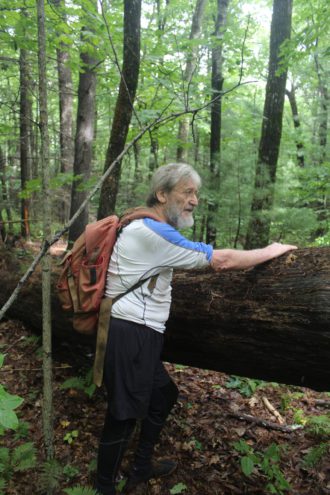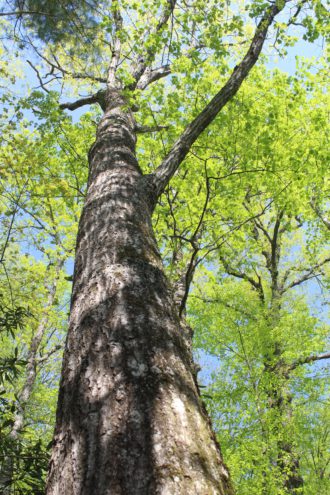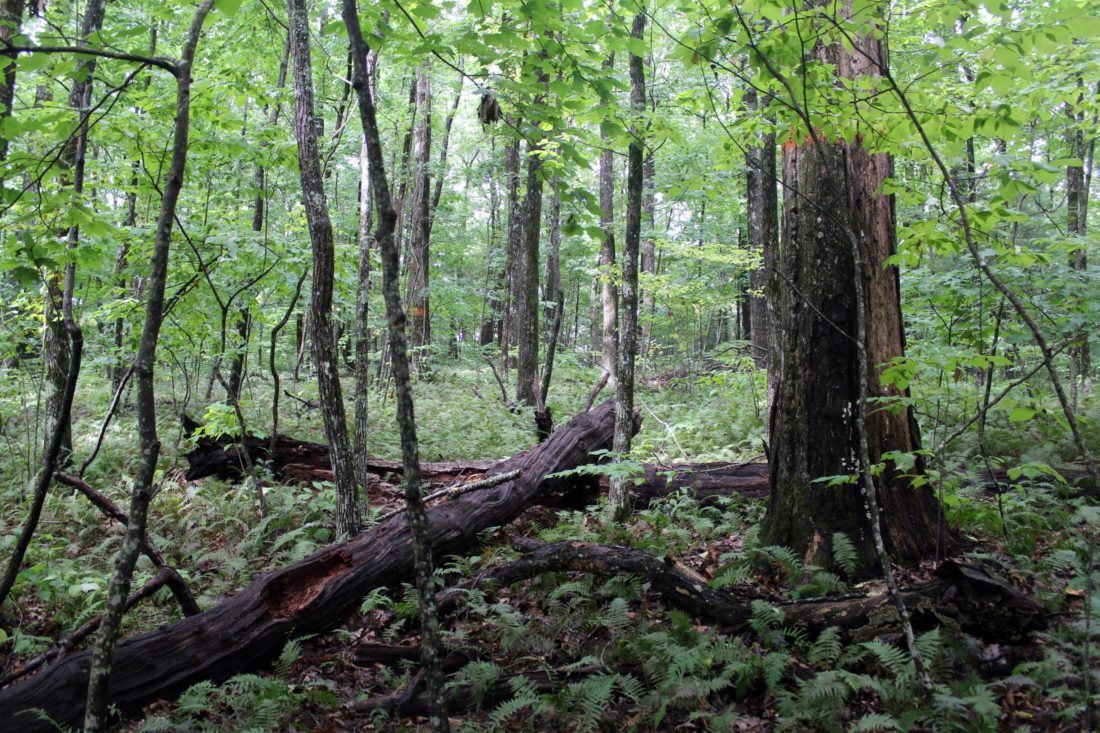By Jack Igelman, originally published by Carolina Public Press. Carolina Public Press is an independent, in-depth and investigative nonprofit news service for North Carolina.
CPP is launching a four-part series focusing on the Southside Project, a recent initiative by the U.S. Forest Service, to make the national forest more resilient and sustainable. In part one, Jack Igelman provides the context and background for the Southside Project, Brushy Mountain and the new Forest Service plan.
On a cloudy morning in August, Buzz Williams is standing at the trunk of a venerable black gum tree over a century old on Brushy Mountain in Nantahala National Forest. The forest lies in the mountains and valleys of southwestern North Carolina and is the largest of North Carolina’s four national forests.
Williams is tall and slim with a thick white beard. When he’s moving, he bounds through the forest, talking the entire way, occasionally stopping to examine some of the forest’s bounty, including a poisonous mushroom and an American chestnut sapling before stopping at the trunk of the black gum.
“Bark is one of the best ways to age a forest,” said Williams. Working out a forest’s age isn’t just visual, he says; “you can feel it.” Hexagonal patches of gnarly bark outlined by deep fissures create a honeycomb pattern ascending toward its canopy.
The 72-year-old moves easily up a steep mountainside, proof of a lifetime of exploring that began in the woods near his childhood home of Pendleton in the South Carolina foothills. Williams works for the Chattooga Conservancy, a nonprofit whose mission is to protect the ecology of the Chattooga River watershed and is based in Mountain Rest, S.C.

Williams is the founder of the organization, serves as an advisor and spends time looking at forest land in the Chattooga River Watershed.
Today he is here to explain to me why a proposed timber restoration project, called the Southside Project, which will harvest the majority of the trees on Brushy Mountain, is the wrong approach to managing this section of the aging national forest.
“There are much better ways to create forest diversity without cutting irreplaceable old-growth timber,” Williams said. “The greatest value of our national forests is to protect biological diversity and to manage them to help us adapt to climate change.”
Brushy Mountain
Brushy Mountain is in Jackson County, several miles south of Cashiers on land between two steep watersheds: the nationally designated Chattooga Wild and Scenic River and the Whitewater River.
Old-growth forest characteristics, such as the one on Brushy Mountain, Williams said, are extremely rare in the Southern Appalachians.
The soil surrounding the black gum’s thick trunk on the ridge top of Brushy Mountain is remarkably spongy to the step. Rotting leaves and other organic material accumulate over decades, forming a carbon-rich layer several inches thick.
Flourishing around the black gum along the ridge are distinct layers of woodland vegetation. At the forest floor are knee-high shrubs of buckberry, an ankle-thick hickory, a fallen red oak, an American chestnut sapling, a sourwood. Among the trees in the aging overstory, Williams recently sampled a core to age a white oak he estimates is over two centuries old.
For Williams, much of the forest’s richness and age is invisible or perhaps easily overlooked. Carpeting the forest floor are patches of lichens and mosses, themselves decades old. Within the soil is a complex web of roots supporting a broad range of life above and below the forest floor, among them the green salamander, a rare and elusive species that nests in rocks but uses deep crevices in old trees, such as the black gum, to forage and for protection from predators and refuge on steamy summer afternoons.
Other than a faint game trail, there’s no footpath to this relatively remote section of woods. There is evidence of disturbance – the stump of a locust tree that was probably cut by a hand saw many years ago, knee-high black locust stump and a bygone fire line below the ridge.
Williams believes this section of forest eluded the industrial-scale logging that occurred in the region over 100 years ago.
“There are a few inaccessible stands that escaped the devastation of the early 1900s with trees that are over 200 years old,” said Williams. “Old-timers called the old trees left standing “wolf trees.” Brushy is one of those rare sites that, for the most part, escaped heavy logging and functions as an interconnected old-growth forest. It’s certainly more than just a few old wolf trees.”
The Southside Project
The recent timber sale to harvest 37 acres that encompass an old-growth patch of forest on Brushy Mountain underscores what some say is the widening incongruity between the U.S. Forest Service’s mission, the climate crisis and the public’s will.
The Forest Service decided to harvest trees here as part of the Southside Project, which the agency said is desperately needed to restore habitat and “improve and maintain wildlife habitat, species diversity of forest stands, soil and water resources, and forest health through vegetation management” as set out on its website. Among the objectives of the revised forest management plan due to be completed within the next several months is to encourage forest health by creating a greater diversity of forest types, ages and structures so forests are more resilient to climate change, insects and other threats.
The Southside Project is intended to provide more early successional habitat — that is, managing the forest to include more grassy openings, shrubs and stands of trees less than 20 years old — through prescribed burning, timber thinning and other methods to improve species diversity and wildlife habitat. Expanding the range of underrepresented early successional habitat is among the plan’s key strategic goals to enhance forest diversity.
In all, the project will execute timber prescriptions, which can involve cutting trees, using fire and other techniques to manage the forest. This will be done on more than 300 acres in 23 separate stands within a 19,000-acre section of national forest land near the Georgia and South Carolina state lines. The average size of each stand is 22 acres, or each roughly the size of 12 soccer fields.
The project may explain not only how the Forest Service views the Brushy Mountain decision but also hints at how the agency will manage old growth throughout 1 million acres of national forest in Western North Carolina over the next two decades.
Brushy Mountain is a portion of the first of three timber sale offerings from the Southside Project. Two additional timber sales are on hold pending the release of the forest plan. There is no timeline for the harvest on Brushy Mountain, although activities there must be completed by Nov. 15, 2026.
History of Southside Project
In August, the U.S. Forest Service accepted a $55,604 bid from Parton Lumber, based in Rutherfordton, to cut 37 acres on two sites on Brushy Mountain as part of the Southside Project. The timber sale included 61 acres of timber in the Jacks Creek watershed. A map of the area can be viewed here.
A painted orange ring around the black gum now indicates trees will be spared, but in reality, however, most of the canopy on this site will be cut.
According to the Forest Service, the project does not include clear-cutting. While the majority of the trees on Brushy Mountain will be harvested, trees with cavities for bat migration and nut-producing trees will be left in clumps or dispersed throughout the stand to create a forest with two distinct age classes.
In an email, Forest Service public affairs officer Cathy Dowd said that roughly half of a 26-acre stand on the summit of Brushy Mountain “minimally meets the definition of old growth.” The Forest Service defines old-growth forest as being in the later stages of development and has a variety of characteristics that may include tree size, accumulations of large dead woody material, number of canopy layers, species composition and ecosystem function
According to the Forest Service, the stand on Brushy Mountain must meet the following criteria to be considered existing old growth by the Forest Service:
- 30 trees per acre greater than 130 years-old.
- A rate of six-10 trees per acres with a 20-inch diameter.
- No evidence of past human activities.
- Meet a minimum tree density threshold.
The criteria for conserving and restoring old-growth forest communities in the Southeastern national forests was developed in June 1997.
Yet, the definition of stands of old growth by scientists and experts has evolved and varies depending on the ecosystem. In general, old growth is distinguished by, of course, old trees but also includes other forest structural attributes, such as the number of canopy layers, climate, location and past disturbances from nature and humans.

From the Forest Service’s point of view, in this case, transforming the stand to an open section of forest outweighs the ecological function as an aging forest. Within the 19,000 acres in the project’s analysis area, the majority of forest is 80 years or older.
According to Dowd, the aging acres of forest on Brushy Mountain that Williams wants protected is not rare.
“There’s already nearly 7,000 acres of the same forest structure in the Southside Project that will not be harvested,” she said, referring to forests that were logged a century ago.
Instead, what is rare, according to Dowd, are forest openings essential to create habitat for species that depend on early successional habitat, such as ruffed grouse and the golden-winged warbler.
Biologist Josh Kelly of MountainTrue said the claim of 7,000 acres of the same age class and structure class is untrue and misleading. For one, Kelly claimed that, according to agency data, only a portion of that acreage — 2,377 acres — exceeds 130 years old. Those portions of forest, however, “have yet to be field-verified or evaluated for old-growth characteristics.”
“It’s old growth on paper only,” he said. The stand on Brushy Mountain has been evaluated and has “canopy trees in excess of 220 years of age and numerous trees over 150 years of age.”
Definition of old growth
To a casual observer, a hulking, old tree with an expansive canopy is impressive, but it may not dwell in an old-growth stand. Clusters of trees and their surrounding environment, rather than a single old tree, are what experts consider in evaluating the characteristics of an old-growth forest.
The Forest Service defines old-growth forest based on the unique biophysical character of each of the agency’s nine regions. What ultimately is considered old growth is influenced by, among other things, the makeup of tree species, climate, soil and the history of forest disturbance, such as past logging.
Tree size is also not a feature of an old-growth forest. For example, relatively dry and rocky conditions on a ridge top may constrain the size of a two-century old oak that may tower in a different setting. Most scientists agree that old-growth forests differ widely in character with age, geographic location, climate, among other factors. The Southeastern U.S. has 16 old-growth forest community types on national forest lands.
In the late 1990s and early 2000s, Hugh Irwin of the Wilderness Society said the Southern Appalachian Forest Coalition and the WNC Alliance (now MountainTrue) surveyed Pisgah and Nantahala national forests, documenting more than 80,000 acres of existing old-growth forest, representing less than 10% of land within the two national forests.
“The Forest Service’s natural range variation models say that 50% of the forest should be in old-growth condition,” said Irwin. “So, we’re way below what we should have. It’s stunning that when the Forest Service is supposed to be inventorying old growth, they would actually be liquidating it.”
The Forest Service uses a variety of practices to manage timber within the national forests. Timber harvests are used to create mixed-aged forests that support ecosystem diversity and wildlife habitat connectivity. Timber harvest also supports the region’s forest products economy.
However, finding environmentally suitable and economically feasible sites to harvest trees without disrupting other uses, such as recreation, or other ecosystem benefits of the forests, including water quality or the conservation of small patches of old-growth trees, is difficult.
The economics of timber harvesting in the national forest have made it increasingly challenging to attract bidders. Occasionally, a timber sale will receive no offers, such as the recent Twelve Mile Project in Haywood County. The project, however, did eventually receive a bid for the proposed rate, according to the Forest Service.
The Brushy Mountain timber sale was initially offered in the summer of 2021. Then, the minimum bid price was $96,675. The sale received no bids and was reposted in the summer of 2022 with a minimum bid price of $49,351. According to the Forest Service, the lower bid price was the result of changing market conditions, such as lower wood price, rising fuel costs and distance to mills. In addition, the Forest Service said its objective is not to maximize profit on the sale but rather to improve wildlife habitat and forest health.
Among the considerations in a timber harvest project are the cost of access and the mix and value of the lumber. Remote sites are costlier and, depending on the variety of trees, many acres of the forest simply aren’t valuable enough to attract bidders. Small patches of old growth may also add management costs and headaches to future timber projects, according to internal Forest Service documents.
In addition, hundreds of thousands of acres of the national forest aren’t available to harvest, including designated wilderness, the Appalachian Trail Corridor and other designations that prohibit or restrict cutting trees.
Maintaining biodiversity and a range of forest age classes, say scientists, makes ecological systems more resilient by increasing the likelihood that plant and animal species survive changing climatic conditions, such as longer periods of drought or more extreme rainfall.
The woodlands of Western North Carolina are still recovering from industrial scale logging and the American chestnut blight in the early decades of the 20th century. The purchase of vast sections of forest by the U.S. government that followed aided their protection.
However, a century later, forests in the region aged in step. They flourished into thousands of acres of relatively mature trees with a uniform age structure, making them vulnerable to a range of potential hazards. Climate change may directly or indirectly impact the health of forests through changes in rainfall, insect outbreaks, the risk of prolonged droughts, extreme weather events such as storms and changing seasons. On top of that, there is pressure from development, air pollution and wildfire.
Those impacts, combined, may very well alter Western North Carolina forests as we know them.




The cutting of our mature hardwood forests -particularly as our increasingly and undeniably planetary “situation” worsens- is an absolute travesty. And the argument that the cutting of these mature forests produces “healthier” forests is complete and total bullshit. What it does produce is immediately degraded water quality within the watershed… along with more flooding, vanquished basically forever biodiversity, and severely degraded wildlife habitat. What it also does though is keep the local dinosaur timber extraction businesses.. the sawmills, chip mills, and the newly spawned wood pellet “biomass” mills …humming. Period, end of story. And the notion that the US Forest Service’s timber harvesting “scientific quotas” are about science is nothing short of ludicrous. The Forest Service’s timber extraction quotas are a purely political calculus driven by their completely outdated “mission mandate” under the auspices of the US Dept of Agriculture.. of which they are very much part and parcel of. The 55k that the Parton Lumber Company of Rutherfordton is paying for this magnificent stand of irreplaceable old growth forest up there on Brushy Mountain won’t even cover the cost of the roads that the Forest Service will be required to put in, in order to reach this remote stand of untouched forest. This can’t continue ..this shortsightedness ..to put it kindly. We can do better… we must do better.
The cutting of our mature hardwood forests -particularly as our increasingly and undeniably planetary “situation” worsens- is an absolute travesty. And the argument that the cutting of these mature forests produces “healthier” forests is complete and total you know what. What it does produce is immediately degraded water quality within the watershed… along with more flooding, vanquished basically forever biodiversity, and severely degraded wildlife habitat. What it also does though is keep the local dinosaur timber extraction businesses.. the sawmills, chip mills, and the newly spawned wood pellet “biomass” mills …humming. Period, end of story. And the notion that the US Forest Service’s timber harvesting “scientific quotas” are about science is nothing short of ludicrous. The Forest Service’s timber extraction quotas are a purely political calculus driven by their completely outdated “mission mandate” under the auspices of the US Dept of Agriculture.. of which they are very much part and parcel of. The 55k that the Parton Lumber Company of Rutherfordton is paying for this magnificent stand of irreplaceable old growth forest up there on Brushy Mountain won’t even cover the cost of the roads that the Forest Service will be required to put in, in order to reach this remote stand of untouched forest. This can’t continue ..this shortsightedness ..to put it kindly. We can do better… we must do better.